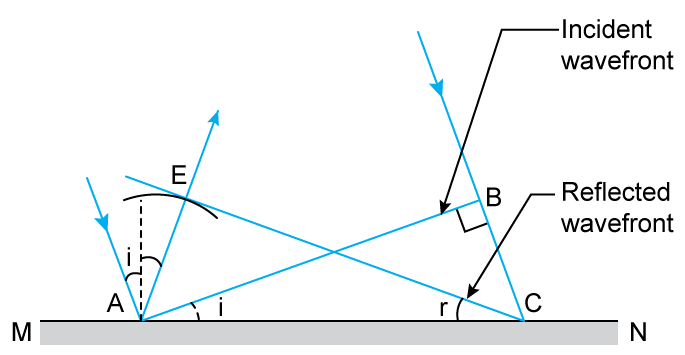
Note that sound has a very wide frequency range (from 20 to about 17,000 Hz), and thus a very wide range of wavelengths (from about 20 mm to 17 m). When a longitudinal sound wave strikes a flat surface, sound is reflected in a coherent manner provided that the dimension of the reflective surface is large compared to the wavelength of the sound. They are used in nuclear reactors and nuclear weapons. Some materials, such as beryllium, can reflect neutrons.

A conjugate reflector can be used to remove aberrations from a beam by reflecting it and then passing the reflection through the aberrating optics a second time. In this type of reflection, not only the direction of the light is reversed, but the actual wavefronts are reversed as well. Light bounces exactly back in the direction from which it came due to a nonlinear optical process. In this application, perfect retroreflection is not desired since the light would then be directed back into the headlights of an oncoming car rather than to the driver's eyes.
#ANGLE OF INCIDENCE EQUALS ANGLE OF REFLECTION LICENSE#
This is used to make traffic signs and automobile license plates reflect light mostly back in the direction from which it came. In both cases, internal reflection causes the light to be reflected back to where it originated. The image produced is the inverse of one produced by a single mirror.Ī surface can be made partially retroreflective by depositing a layer of tiny refractive spheres on it or by creating small pyramid like structures (cube corner reflection). A simple retroreflector can be made by placing three ordinary mirrors mutually perpendicular to one another (a corner reflector). The structure of these surfaces is such that light is returned in the direction from which it came. The exact form of the reflection depends on the structure of the surface. When light strikes a rough or granular surface, it bounces off in all directions due to the microscopic irregularities of the interface. Such mirrors may have surfaces that are spherical or parabolic. Specular reflection at a curved surface forms an image that may be magnified or demagnified curved mirrors have optical power. This is an important principle in the field of thin-film optics. By contrast, a less dense, lower refractive index material will reflect light in phase. When light reflects off a material denser (with higher refractive index) than the external medium, it undergoes a 180° phase reversal. Total internal reflection of light from a denser medium occurs if the angle of incidence is above the critical angle (minimum angle of incidence at which total internal reflection occurs). Solving Maxwell's equations for a light ray striking a boundary allows the derivation of the Fresnel equations, which can be used to predict how much of the light is reflected, and how much is refracted in a given situation. In the most general case, a certain fraction of the light is reflected from the interface, and the remainder is refracted. In fact, reflection of light may occur whenever light travels from a medium of a given refractive index into a medium with a different refractive index. Whether the interfaces consist of dielectric-conductor or dielectric-dielectric, the phase of the reflected wave may or may not be inverted.Ī black triggerfish and its reflection in the water surface. Reflection of light may be specular (that is, mirror-like) or diffuse (that is, not retaining the image, only the energy) depending on the nature of the interface. The reflection of visible light is also often used for aesthetic purposes.

The reflection of seismic waves allows researchers to study the Earth's structure and to prospect for petroleum and other natural resources. The reflection of sound waves in a theater or concert hall enlivens an onstage production.

The reflection of microwaves is useful for radar scanners. For instance, the reflection of visible light allows us to see objects that do not produce their own light. The phenomenon of reflection is extremely valuable for our daily lives. Common examples include the reflection of light, sound, and water waves. Reflection is the change in direction of a wave front at an interface between two dissimilar media so that the wave front returns into the medium from which it originated. Spheres reflecting the floor and each other.


 0 kommentar(er)
0 kommentar(er)
